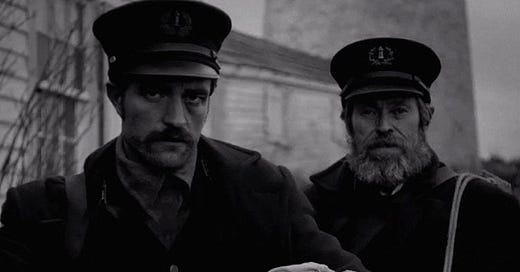#2: The Lighthouse and Hauntological Horror
Second in a three part miniseries on horror movies and hauntology. Contains spoilers. And an early 20th century painting of a willy.
If Skinamarink revels in hauntology’s imminence, Robert Egger’s 2019 The Lighthouse moves in the opposite direction. As the director’s previous, debut, feature, 2015’s The Witch, stitched its screenplay from witch trial testimonies, so The Lighthouse pulls from maritime journals, jigs and Sascha Schneider’s Hypnosis (1904):
In The Forbidden Room, Guy Maddin explores once popular, but now forgotten, genres of cinema through amnesia. In conversation with David Spittle, from Light Glyphs: The Collected Interviews (Broken Sleep Books, 2021), Maddin reflects on memory in relation to dreaming:
I saw these dreams as a forgetting. I’d forgotten all the funerals, the deaths. I’d forgotten it was no longer summer, at least while I was sleeping. I’d forgotten people were dead, and the feelings of seeing them again, that’s what I remembered. In a way, forgetting is not just the flip side of remembering, but an important part of remembering. I’d forget one thing, the absence, and that would permit me dream access to the memory of things long removed from me. It was like getting handed a telescope in my sleep, so I could see and feel things up close I would never be able to conjure up as simple daytime memories, not without the vividness of dreams.
Far from that gross, ideologically predicated discourse that memories are so fallible they can’t ever be true (see the documentary, The Keepers, for an excellent, albeit upsetting, explanation of how the Catholic Church paid off medical professionals to misleadingly theorise repressed memories were invalid) Maddin realises absence provides form. Remembering becomes holistic: not a mechanical recall of events, but a thing breathed by experience that is one and the same with the body.
Yet there’s a distinction between The Forbidden Room and The Lighthouse. Maddin uses amnesia on cinema’s terms - a femme fatal who can’t remember her past; a horror protagonist subjected to outdated brain surgery to “cure” anal fixation - whereas, in Eggers’ film, the acknowledgment of any memory, remembered or lost, is taboo.
When Thomas asks Winslow for a back story, Winslow is aloof. Conversely, Thomas carries the memory of the sea, of lighthouse keeping, which Winslow either bucks against or outright ignores, as with his murder of a seagull: one of the handful of actions that reverberates through and shatters the film as seagulls are “the souls of sailors who met their maker”. The land is plagued by forgotten dead. When Winslow finally acknowledges his past, when he “spills his beans”, it pushes the film towards its grim conclusion.
For Maddin, an expanded definition of memory - one which includes dream and amnesia - is a gesture towards a whole. This is by no means totalised or systematic (to reiterate, memory, for Maddin, is given form by its eclipsing) but really is just a gesture. For Eggers, this can be attempted but can’t be seen lest it tear apart a character’s being and the film along with it.
The sexual components of this are obvious. The duo in The Lighthouse, as they lapse time and repeatedly reverse roles, spoon, engage in role play, squabble and almost kiss. As Winslow hides his fantasy of having sex with a mermaid, Thomas refuses to let him, pun intended, see the light. Winslow understands why when he spies on Thomas masturbating to its radiance.
In a sense, The Lighthouse does find imminence in Winslow’s eventual confrontation with the light. Thomas says the previous lighthouse keeper saw salvation in it, a fire bestowed by St Elmo himself. Yet, where Skinamarink’s Kevin and Kayleigh are consumed by hauntological imminence, Winslow can’t withstand it anymore than he can withstand the brutal reality of his existence. The light compels him back, tumbling down the stairs (a fall, as in Eden - rejected from a state of grace) to be disembowelled by seagulls. Indeed, St Elmo is the patron of abdominal pains as well as sailors.
The Lighthouse begs the question what would happen if the audience confronted the film’s repressed signifiers, like Winslow confronts the light. If the film has an answer, it indicates it’s too ineffable to comprehend. A viewer can never fully understand a sign without its context. Instead, a refusal of the past breaks in. The audience have been confronted by hauntology negated.
Bits and Pieces
The revered editor of Mercurius Magazine, Thomas Helm, asked me to contribute my favourite 21st century novels. You can read the feature here.
Hem Press has its next release coming 24th March. As such, Exorcism Becomes Habit by Nikki Dudley is available to preorder.





